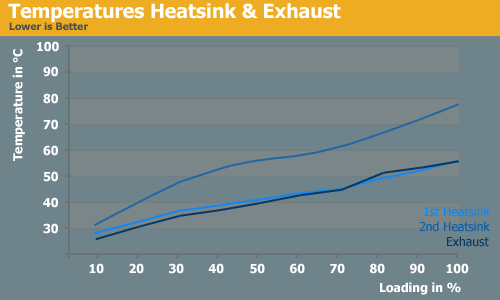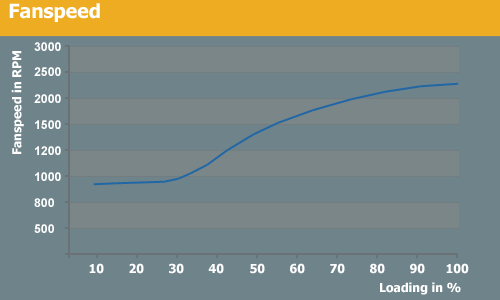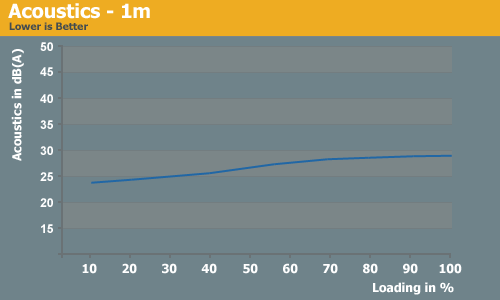The Enermax Liberty - Getting long in the tooth, but still worth a look
by Christoph Katzer on July 30, 2007 1:40 AM EST- Posted in
- Cases/Cooling/PSUs
Temperatures

Room Temperature

During the room temperature test the temps of the heatsinks is very low. At only 50°C on the secondary heatsink and 40°C on the primary it is definitely a good result. This has a lot to do with the fan, which begins increasing its rotational speed rapidly at loads above 50%. The heatsink design helps as well, as it leaves enough air so that components under it can be cooled as well.
Fan Speed

Room Temperature

The curves of the two different ambient temperatures look similar; they only differ in maximum speed and the point at which the fan starts rotating faster. At room temperature fan speed starts ramping up at around 40% of load (around 250W). The curve then goes steadily up to its highest point of almost 2000 RPM. With higher ambient temperature the fan starts to spin faster at 30% load which is an approximate 190W. We measured a difference of about 250 RPM between the two ambient temperatures.
Acoustics

Room Temperature

The two tests at room temperature and high temperature show clear differences in terms of noise levels. We measured 5dB(A) more under high temperatures when the fan was spinning 250 RPM faster. Enermax doesn't make a big deal about noise levels and has always stated that they prefer to have a well-performing power supply which can only be done by a fan that actually moves enough air through the housing. Enough air means that the fan needs to spin at higher speeds, and that means it will produce more noise. In comparison to some of the higher power units we've looked at the Liberty does quite well at being quiet; then again, it's only providing a maximum of 500W vs. 850W on some of the units we've tested.

Room Temperature

During the room temperature test the temps of the heatsinks is very low. At only 50°C on the secondary heatsink and 40°C on the primary it is definitely a good result. This has a lot to do with the fan, which begins increasing its rotational speed rapidly at loads above 50%. The heatsink design helps as well, as it leaves enough air so that components under it can be cooled as well.
Fan Speed

Room Temperature

The curves of the two different ambient temperatures look similar; they only differ in maximum speed and the point at which the fan starts rotating faster. At room temperature fan speed starts ramping up at around 40% of load (around 250W). The curve then goes steadily up to its highest point of almost 2000 RPM. With higher ambient temperature the fan starts to spin faster at 30% load which is an approximate 190W. We measured a difference of about 250 RPM between the two ambient temperatures.
Acoustics

Room Temperature

The two tests at room temperature and high temperature show clear differences in terms of noise levels. We measured 5dB(A) more under high temperatures when the fan was spinning 250 RPM faster. Enermax doesn't make a big deal about noise levels and has always stated that they prefer to have a well-performing power supply which can only be done by a fan that actually moves enough air through the housing. Enough air means that the fan needs to spin at higher speeds, and that means it will produce more noise. In comparison to some of the higher power units we've looked at the Liberty does quite well at being quiet; then again, it's only providing a maximum of 500W vs. 850W on some of the units we've tested.










26 Comments
View All Comments
MCSim - Tuesday, July 31, 2007 - link
400W Liberty here. Mine is also about 2 years old and still going strong. There's no need for new PSU. :)wolfman3k5 - Monday, July 30, 2007 - link
Just out of curiosity, did you guys run out of stuff to write about?leexgx - Monday, July 30, 2007 - link
hehi had the 400W Enermax PSU for 2 years now and its powering my server quite happy (8 hdds and an old P4 2.6ghz 2gb ram) never had an problem with them (use thermaltake TR2 420W-500w now for basic PSU as its the only good ones on my local trade lists never had one blow on me)
CuriousMike - Monday, July 30, 2007 - link
fwiw, I bought two 350w enermax "basic" powersupplies about 2 years ago ( built two new machines for home.)One of the units fans developed a bad squeek about 2 months into ownership.
I tried contacting enermax in two different ways - both via email.
One was their usa (my locale) website (which I think was a distributor site?), and the other their taiwanese/chinese site.
Never heard back from them.
JarredWalton - Monday, July 30, 2007 - link
The squeaky PSU gets the new fan, and the squeaky wheel gets the oil. You just need to squeak a bit louder probably. That or you got unlucky. I haven't dealt with Enermax directly, but I have had a few companies (DFI, for example) where it took several email messages to get help. Not good at all, but eventually they did respond. The fact that their email support form fails 75% of the time didn't help, of course.Vidmar - Monday, July 30, 2007 - link
While I think the Efficiency charts in load percentage are nice, if you included Efficiency charts in watts it would be more informative from a buying perspective.The reason? I know the sum of system load is 375watts normally. The way it is now, if power supply XYZ has a max load of 650watts, I have to calculate where my ~375watts falls into that load chart (~57% load). But if the next power supply has 1000 watts max, then I have to yet again calculate what load percentage that may be for *that* power supply. If the Efficiency charts were in watts, instead of load, no calculations would be necessary. If I could look at your charts and see that XYZ power supply provided those watts the most efficiently, that would be the power supply I would get.
Maybe you could just provide a second X axis on the chart that included the watts.
Thanks!
michal1980 - Monday, July 30, 2007 - link
Owned for for probably 18+ months now. It was a replacement for the early problems the antec neo-he's had. and I bought it at a retail store for about 110 bucks. I had no idea if it was good because it was so cheap (for a retail store, everyother branded 500w psu was 150~180 bucks).its given me good stable power for all these years, and I hope for a few more.
kmmatney - Monday, July 30, 2007 - link
I've owned a 550W Enermax PSU for over 5 years! It was originally made for the old Thunder K7 dual AMD motherboards, but it now powers my Core 2 Duo. It's been a great power supply - never thought it would last so long. I did recently re-oil the fan (still running on the original fan as well).mostlyprudent - Monday, July 30, 2007 - link
Nice review. I appreciate the diversion from the high end. I have been wondering how newer models would stack up against an old favorite. It is nice to see that there is a little more happening in the PSU industry than just wattage hikes.Thinkitect - Monday, July 30, 2007 - link
Almost!Value PSU review? Quality Benchmarks? Fortron Source!
FSP Group products should be the baseline for the reviews and price/performance rating.
The AX-400 and AX-500 for value were great (and still are), though efficiency may be outdated. The blue series should be the one to compare to right now.
I've used the same AX for years through many upgrades, and it now powers a relative's workstation. I have the BlueStorm II 500 powering my new gaming rig, and now there are the FX-600-GLN and FX-700-GLN with even higher efficiency ratings.
High quality well priced components that deserve the comparison and recognition.